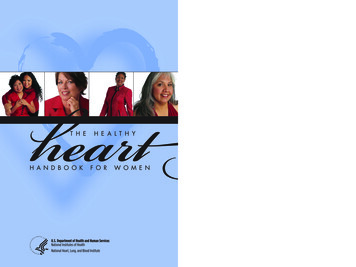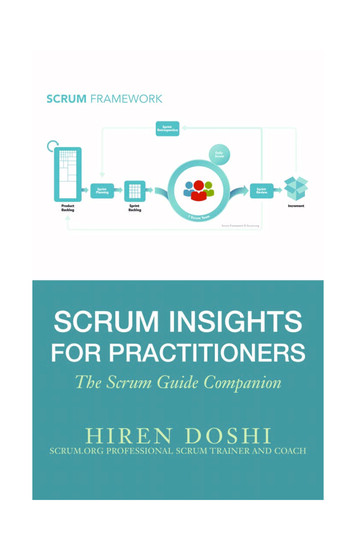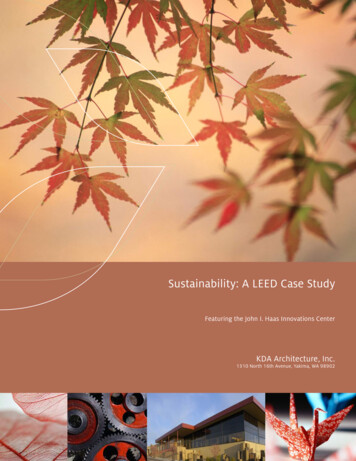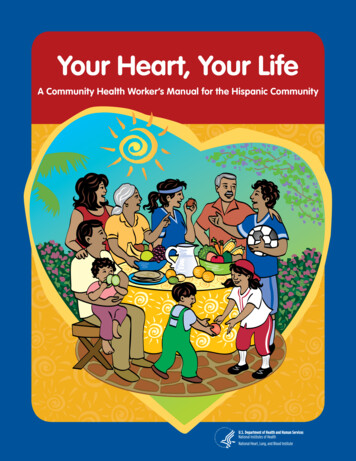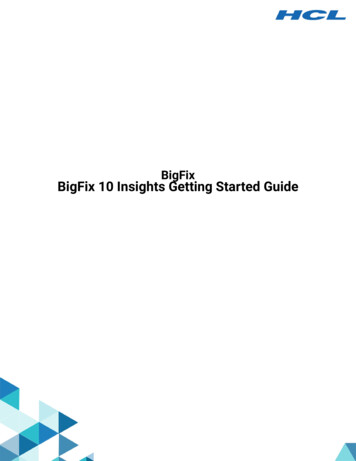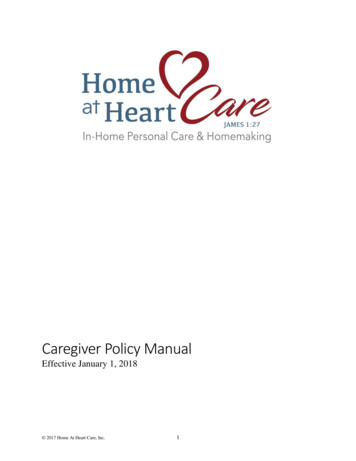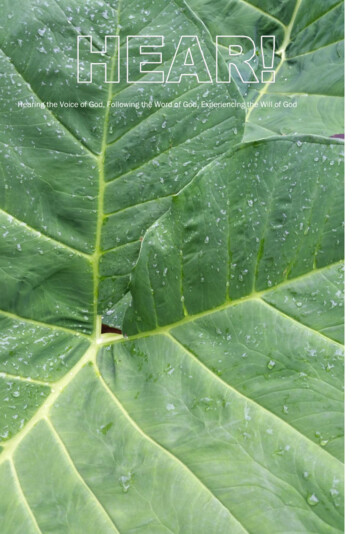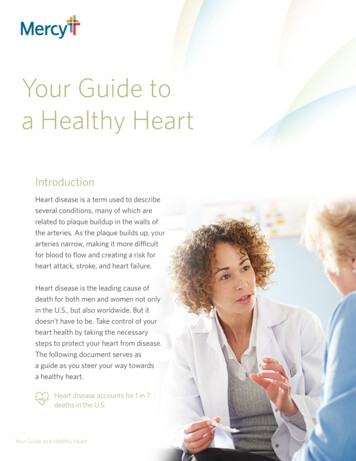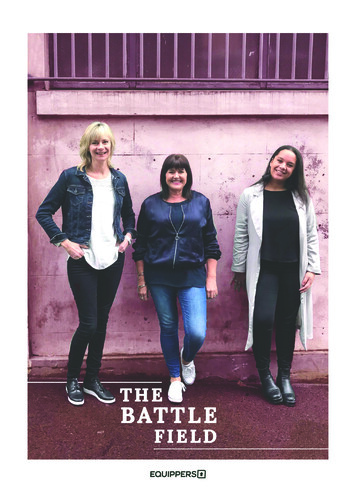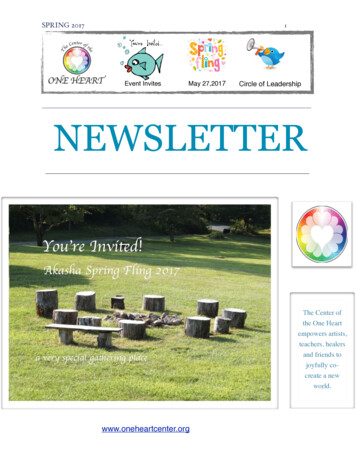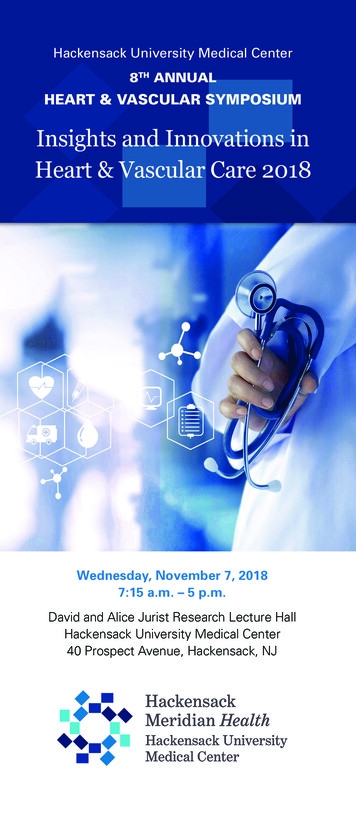
Transcription
Hackensack University Medical Center8TH ANNUALHEART & VASCULAR SYMPOSIUMInsights and Innovations inHeart & Vascular Care 2018Wednesday, November 7, 20187:15 a.m. – 5 p.m.David and Alice Jurist Research Lecture HallHackensack University Medical Center40 Prospect Avenue, Hackensack, NJ
Registration InformationREGISTER ONLINE ON FEE: Complimentary to Hackensack UniversityMedical Center employees/physicians/housestaff/students and members of HackensackMeridian Health – ID required. 75 registration fee for all non-HackensackUniveristy Medical Center physicians and a 50 registration fee for all non-HackensackUniversity Medical Center non-physicians. Members of the American College ofCardiology may pay the 50 registration feewhich includes conference and lunch/coffeebreaks.FOR MORE INFORMATION:Email: ellen.lawlor@hackensackmeridian.org
Heart & Vascular Hospital8TH ANNUALHEART & VASCULARSYMPOSIUMInsights and Innovations inHeart & Vascular Care 2018Wednesday, November 7, 20187:15 a.m. – 5 p.m.David and Alice Jurist Research Lecture HallHackensack University Medical Center40 Prospect Avenue, Hackensack, NJheart.HackensackUMC.org/2018Symposium
PURPOSE:This symposium is designed to provide internists,cardiologists, surgeons, nurse practitioners andother healthcare providers with a review of thecurrent approaches in the treatment of cardiac andvascular disease to improve their knowledge baseso that they may employ the latest approaches. Thisprogram will provide a review of the rapid changes inheart and vascular disease, atrial fibrillation, ischemicheart disease, interventional procedures, structuralheart disease, heart failure and valvular disease.OBJECTIVES:At the conclusion of this learning activity theparticipants should be able to: Cite indications and complications of catheterbased transaortic valve replacement (TAVR) inpatients with aortic stenosis Review indications and management of mitralvalve disease using mitral clips and minimallyinvasive surgery Describe indications and management formechanical ventricular assist devices (VADs) Review the indications and contraindications forExtracorpreal Membrane Oxygenation (ECMO) Describe new programs in the EmergencyDepartment Center for the managementand treatment of chest pain and analyze theoutcomes of a cardiologist in the ETC. Review management of aortic, carotid, andperipheral vascular disease Review medical, catheter-based and surgicaloptions for treating patients with abdominalaortic aneurysms, peripheral arterial disease andacute stroke Differentiate the factors for selection ofpharmacologic and interventional approachesin the diagnosis and management of selectcardiovascular and neurovascular diseases Evaluate lifestyle management issues suchas obesity, smoking, sleep apnea, alcoholconsumption, and exercise effect the courseof atrial fibrillation and effect prognosis aftervarious treatments including ablation andthe treatment course of directing patients toconsider lifestyle issues before proceeding toinvasive procedures.
Review genetic basis for important cardiacarrhythmias Review diagnostic criteria, conventionaltreatment and new interventional therapies forvenous thrombotic disease. State the need for high quality cardiovascularcare during and after cancer therapy. Describe the importance of physical activity,exercise and cardio-respiratory fitness forprotecting against major cardiac morbidityand mortality. Review data on optimal cardiacprevention and discuss potential benefits ofcardiac rehabilitation and exercise training Evaluate contemporary data on the indications,safety and efficacy of carotid revascularization.Review outcomes of Trans-Carotid ArteryRevascularization (TCAR) and anatomiclimitations of TCAR technology. Describe the difference between Type A andType B Aortic dissection and the differencebetween complicated and uncomplicated Type BAortic Dissections and the urgency for treatmentfor each of them. Identify the accelerating changes in cardiovascular disease outcomes and the impact of newinterventions on management of structural heartdisease, heart failure, and atrial fibrillation.ACCREDITATION STATEMENT:Hackensack University Medical Center is accreditedby the Medical Society of New Jersey to providecontinuing medical education for physicians.AMA CREDIT DESIGNATION STATEMENT:Hackensack University Medical Center designatesthis live activity for a maximum of 8 AMA PRACategory 1 CreditTM. Physicians should claim onlythe credit commensurate with the extent of theirparticipation in the activity.NURSING CONTACT HOURS: 7.75:Hackensack University Medical Center, is anapproved provider of continuing nursing educationby the New Jersey State Nurses Association, anaccredited approver by the American Nurses.
Symposium Agenda7:15 a.m.REGISTRATION/CONTINENTAL BREAKFAST7:45 a.m.INTRODUCTION/OVERVIEWJOSEPH E. PARRILLO, M.D.Chairman, Heart & Vascular Hospital (HVH)Hackensack University Medical CenterVALVULAR, STRUCTURAL ANDCONGENITAL HEART DISEASEMODERATOR: DAVID B. LANDERS, M.D.Vice Chairman, Heart & Vascular HospitalHackensack University Medical Center8 a.m.Mitral Valve: Non-Surgical Repair and ClippingCARLOS E. RUIZ, M.D.Describe mitral valve unique pathology and themethods to repair the valve using catheters, wires,clips and other non-surgical techniques.8:15 a.m.Mitral Valve: Surgical - MinimallyInvasive RepairMARK B. ANDERSON, M.D., FACSExplain pathogenesis of mitral valve disease andreview minimally invasive surgical techniques to repairthe valve.8:30 a.m.Aortic Valve: TAVR in 2018ELLIE ELMANN, M.D.Review current state of transcatheter aortic valverepair (TAVR) nationally, internationally and atHackensack University Medical Center.8:45 a.m.Echo Imaging in Interventional ProceduresLUCY SAFI, D.O.Evaluate and describe current interventionalechocardiographic techniques to optimally image theheart valves and chambers to guide structural heartinterventions.9 a.m.Questions/Discussion
KEYNOTE ADDRESSMODERATOR:ANTHONY J. PASSANNANTE JR., M.D., FACCPresident, Palisades Medical CenterHackensack Meridian Health9:15 a.m.Special SpeakerHealthcare & Physicians in 2018J. SANFORD SCHWARTZ, M.D.Professor of Medicine,University of Pennsylvania/Wharton9:45 a.m.Questions/DiscussionARRTHYMIAS AND STROKEMODERATOR: FLORIAN THOMAS, M.D.Chairman, NeurosciencesHackensack University Medical Center10 a.m.Atrial Fibrillation and Lifestyle ManagementTAYA GLOTZER, M.D.Review the most common arrhythmia, atrialfibrillation, and evaluate role of lifestyle modification inmanagement.10:15 a.m.Atrial Fibrillation: Pharmacotherapyand AblationJOHN ZIMMERMAN, M.D.Evaluate treatment of atrial fibrillation usingphamaceutical agents versus catheter ablationmethodology.10:30 a.m.Atrial Fibrillation: Treatment with LAAppendage OcclusionGUNJAN SHUKLA, M.D.State the role of left atrial appendage occlusiondevices (such as Watchman) in management of atrialfibirillation patients.10:45 a.m.Stroke Prevention using Patent ForemanOvale ClosureZOLTAN TURI, M.D.Review importance of closing patent foreman ovale(PFOs) using catheter techniques in prevention of stroke.
11 a.m.Treating Acute Stroke with CatheterInterventionDANIEL WALZMAN, M.D.Describe use of catheter based methods in treatmentof acute strokes in evolution.11:15 a.m.Questions/DiscussionARRTHYMIA ADVANCESMODERATOR: JOSEPH E. PARRILLO, M.D.Chairman, Heart & Vascular HospitalHackensack University Medical Center11:30 a.m.Ventricular Tachycardia Ablation UsingpVAD SupportGRANT SIMONS, M.D.Review treatment of ventricular tachycardia usingcatheter ablation techniques supplemented by supportwith a percutaneous ventricular assist device (pVAD).11:45 a.m.Genetic Arrthymias: Clinical ManagementDIMITRY NEMIROVSKY, M.D.Cite the current understanding of geneticallylinked arrhythmia syndromes and reviewappropriate management.NoonQuestions/Discussion12:15 p.m.Lunch BreakHEART FAILURE AND SHOCK IN 2018MODERATOR: KERI BICKING, PHARM D, BCPSClinical Pharmacy Specialist, Critical CareHeart & Vascular Hopsital, Hackensack UniversityMedical Center1 p.m.Shock Program at Hackensack UniversityMedical Center in 2018JOSEPH E. PARRILLO, M.D.Evaluate the pathogenesis and management ofshock patients who present to Hackensack UniversityMedical Center.
1:15 p.m.Percutaneous Mechanical Assist DevicesKUMAR SATYA, M.D.Review the currently available and futurepercutaneous mechanical assist devices (VADs).1:30 p.m.When Should HF Patients Receive VADs?BERNARD KIM, M.D.Describe the population of heart failure patients whoshould receive permanent VADs.1:45 p.m.Long Term Mechanical Assist Devices (VAD’s)GEORGE BATSIDES, M.D.Review the structure and function of permanentVADs. Identify which devices are idea forspecific patients.2 p.m.VAD Mangement in ICU’s and HomeSCOTT STEWART, APNEvaluate the types of complications and outcomesthat VAD patients develop.2:15 p.m.Questions/DiscussionVASCULAR DISEASEMODERATOR: TAMMY RUSSO, MS, APNDirector of Clinical Operations, Heart & VascularHospital, Hackensack University Medical Center2:30 p.m.Special SpeakerSurgical Education in the Current Era ofTechnology: The Lost Art of Open SurgeryGREGORIO SICARD, M.D., FACSEugene Bricker Professor Emeritus of Surgery andRadiology Washington University, St. Louis MO3 p.m.Alternative Access in Vascular InterventionDAVID O’CONNOR, M.D.State the types of alternative vascular access nowavailable and identify the ideal patients for eachaccess method.
3:15 p.m.Type B Aortic DissectionMICHAEL WILDERMAN, M.D.Describe the difference between type A and Bdissection. Review optimal management of eachtype of disorder.3:30 p.m.Aortic Surgery in 2018GEORGE BATSIDES, M.D.Review current state of advanced aortic surgeryincluding aneursym repair, aortic valve and arch surgery.3:45 p.m.Questions/DiscussionCORONARY ARTERY DISEASEMODERATOR: AARON FEINGOLD, M.D.Chief of CardiologyJFK Medical CenterHackensack Meridian Health4 p.m.Coronary Artery Disease PreventionUsing Advanced Cardiac AssessmentProgram (ACAP)WILLIAM B. SALERNO. M.DDescribe the best methods to detect earlycardiovascular disease (CVD). Review best methods toprevent progression of CVD using lifestyle modification,exercise, diet and pharmacology.4:15 p.m.Left Main Coronary Artery StentingPRANAY VAIDYA, M.D.Identify idea candidates for left main stenting. Reviewthe different techniques to approach severe stenosisof left main coronary artery.4:30 p.m.Questions/Discussion5 p.m.Adjourn
DirectionsFROM GEORGE WASHINGTON BRIDGE EASTFollow Route 80 West, staying local lanes, to Exit 64 B.Turn right onto Polifly Road and travel north on PoliflyRoad. At second light, turn left onto Essex Street. Atfirst light, turn right onto Prospect Avenue. HackensackUniversity Medical Center is on the right.FROM PATERSON AREA AND WESTFollow Route 80 East, staying in local lanes to Exit 63B for Rochelle Park and Paramus. (Exit ramp sign saysExit 63.) Turn left off exit ramp, and turn right at lightonto Essex Street. Follow Hospital Signs. At fourthlight, turn left onto Prospect Avenue. HackensackUniversity Medical Center is on the right.FROM SOUTHERN NEW JERSEY VIA THENEW JERSEY TURNPIKEFollow Route 95-NJ Turnpike north to the junction ofRoute 80. Take 80 west, stay in lanes for “Local Exits” toExit 64 B for Hasbrouck Heights and Newark. Turn right atlight on Polifly Road. At second light, turn left onto EssexStreet. At first light, turn right onto Prospect Avenue.Hackensack University Medical Center is on the right.FROM SOUTHWESTERN NEW JERSEY ON ROUTE 17Follow Route 17 North to Polifly Road turnoff. Gounder the Route 80 overpass and turn left at thesecond light onto Essex Street. Turn at the first rightonto Prospect Avenue. Hackensack University MedicalCenter is on the right.FROM NORTHWESTERN NEW JERSEY ON ROUTE 17Follow Route 17 South to Essex Street exit. Turnleft onto Essex Street. At fourth light, turn left ontoProspect Avenue. Hackensack University MedicalCenter is on the right.FROM THE LINCOLN TUNNELTake Route 3 West to Route 17 North. Proceed on Rt17N to Essex Street exit. Make a right onto EssexStreet. At fourth light, turn left onto Prospect Avenue.Hackensack University Medical Center is on the right.FROM THE GARDEN STATE PARKWAYFrom the Garden State Parkway (north or south),take Route 80 East (Exit 159). Follow Route 80 East,staying in local lanes, to Exit 63 B for Rochelle Park andParamus. (Exit ramp sign says Exit 63.) Turn left off exitramp, and turn right onto Essex Street. Follow Hospitalsigns. At fourth light, turn left onto Prospect Avenue.Hackensack University Medical Center is on the right.
Hackensack University Medical Center8TH ANNUALHEART & VASCULAR SYMPOSIUMInsights and Innovations inHeart & Vascular Care 201830 Prospect AvenueHackensack, NJ 07601REGISTER ONLINE:heart.HackensackUMC.org/2018Symposium
JOSEPH E. PARRILLO, M.D. Chairman, Heart & Vascular Hospital (HVH) Hackensack University Medical Center VALVULAR, STRUCTURAL AND CONGENITAL HEART DISEASE MODERATOR: DAVID B. LANDERS, M.D. Vice Chairman, Heart & Vascular Hospital Hackensack University Medical Cente

